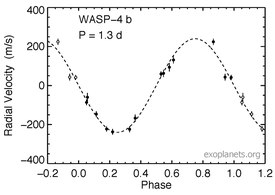WASP-4b
WASP-4b is an exoplanet, specifically a hot Jupiter, approximately 891 light-years away[5] in the constellation of Phoenix.[6]
Discovery
The planet was the discovered by the Wide Angle Search for Planets team using images taken with the SuperWASP-South project's eight wide-angle cameras located at the South African Astronomical Observatory.[7][8][1] Analysis of over 4000 images taken between May and November 2006 resulted in the detection of a transit occurring every 1.3 days. Follow-up radial velocity observations using the Swiss 1.2-metre Leonhard Euler Telescope confirmed that the transiting object was a planet.[1]

Characteristics
The planetary equilibrium temperature would be 1650±30 K,[9] but the measured dayside temperature is higher, with a 2015 study finding 1900±100 K[10] and a 2020 study finding 1957±68 K.[4]
A study in 2012, utilizing the Rossiter–McLaughlin effect, determined the planetary orbit is probably aligned with the equatorial plane of the star, with misalignment equal to -1+14
−12°.[11]
The planet's orbital period appears to be decreasing at a rate of 7.33±0.71 milliseconds per year, suggesting that its orbit is decaying, with a decay timescale of 15.77±1.57 million years. The anomalously high rate of orbital decay of WASP-4b is poorly understood as of 2021.[2]
References
- ^ a b c Wilson, D. M.; et al. (2008). "WASP-4b: A 12th Magnitude Transiting Hot Jupiter in the Southern Hemisphere". The Astrophysical Journal Letters. 675 (2): L113–L116. arXiv:0801.1509. Bibcode:2008ApJ...675L.113W. doi:10.1086/586735.
- ^ a b c Turner, Jake D.; Flagg, Laura; Ridden-Harper, Andrew; Jayawardhana, Ray (2022), "Characterizing the WASP-4 System with TESS and Radial Velocity Data: Constraints on the Cause of the Hot Jupiter's Changing Orbit and Evidence of an Outer Planet", The Astronomical Journal, 163 (6): 281, arXiv:2112.09621, Bibcode:2022AJ....163..281T, doi:10.3847/1538-3881/ac686f, S2CID 245329747
- ^ a b Bonomo, A. S.; Desidera, S.; et al. (June 2017). "The GAPS Programme with HARPS-N at TNG. XIV. Investigating giant planet migration history via improved eccentricity and mass determination for 231 transiting planets". Astronomy & Astrophysics. 602: A107. arXiv:1704.00373. Bibcode:2017A&A...602A.107B. doi:10.1051/0004-6361/201629882. S2CID 118923163.
- ^ a b Wong, Ian; Shporer, Avi; Daylan, Tansu; Benneke, Björn; Fetherolf, Tara; Kane, Stephen R.; Ricker, George R.; Vanderspek, Roland; Latham, David W.; Winn, Joshua N.; Jenkins, Jon M.; Boyd, Patricia T.; Glidden, Ana; Goeke, Robert F.; Sha, Lizhou; Ting, Eric B.; Yahalomi, Daniel (2020), "Systematic Phase Curve Study of Known Transiting Systems from Year One of the TESS Mission", The Astronomical Journal, 160 (4): 155, arXiv:2003.06407, Bibcode:2020AJ....160..155W, doi:10.3847/1538-3881/ababad, S2CID 212717799
- ^ Vallenari, A.; et al. (Gaia collaboration) (2023). "Gaia Data Release 3. Summary of the content and survey properties". Astronomy and Astrophysics. 674: A1. arXiv:2208.00211. Bibcode:2023A&A...674A...1G. doi:10.1051/0004-6361/202243940. S2CID 244398875. Gaia DR3 record for this source at VizieR.
- ^ Roman, Nancy G. (1987). "Identification of a Constellation From a Position". Publications of the Astronomical Society of the Pacific. 99 (617): 695–699. Bibcode:1987PASP...99..695R. doi:10.1086/132034. Vizier query form
- ^ Sherriff, Lucy (2007-10-31). "UK boffins ID three new exo-planets". The Register. Retrieved 2018-09-23.
- ^ "Astronomer discovers new planets". BBC News. 2007-10-31. Retrieved 2018-09-23.
- ^ Table 3, Improved parameters for the transiting hot Jupiters WASP-4b and WASP-5b, M. Gillon et al., Astronomy and Astrophysics 496, #1 (2009), pp. 259–267, doi:10.1051/0004-6361:200810929, Bibcode:2009A&A...496..259G.
- ^ Zhou, G.; Bayliss, D. D. R.; Kedziora-Chudczer, L.; Tinney, C. G.; Bailey, J.; Salter, G.; Rodriguez, J. (2015). "Secondary eclipse observations for seven hot-Jupiters from the Anglo-Australian Telescope". Monthly Notices of the Royal Astronomical Society. 454 (3): 3002–3019. arXiv:1509.04147. Bibcode:2015MNRAS.454.3002Z. doi:10.1093/mnras/stv2138.
- ^ Albrecht, Simon; Winn, Joshua N.; Johnson, John A.; Howard, Andrew W.; Marcy, Geoffrey W.; Butler, R. Paul; Arriagada, Pamela; Crane, Jeffrey D.; Shectman, Stephen A.; Thompson, Ian B.; Hirano, Teruyuki; Bakos, Gaspar; Hartman, Joel D. (2012), "Obliquities of Hot Jupiter Host Stars: Evidence for Tidal Interactions and Primordial Misalignments", The Astrophysical Journal, 757 (1): 18, arXiv:1206.6105, Bibcode:2012ApJ...757...18A, doi:10.1088/0004-637X/757/1/18, S2CID 17174530
Further reading
- Petrucci, R.; et al. (2013). "No Transit Timing Variations in Wasp-4". The Astrophysical Journal Letters. 779 (2). L23. arXiv:1311.2048. Bibcode:2013ApJ...779L..23P. doi:10.1088/2041-8205/779/2/L23. S2CID 118376692.
- Huitson, C. M.; et al. (2017). "Gemini/GMOS Transmission Spectral Survey: Complete Optical Transmission Spectrum of the Hot Jupiter WASP-4b". The Astronomical Journal. 154 (3). 95. arXiv:1707.06575. Bibcode:2017AJ....154...95H. doi:10.3847/1538-3881/aa7f72. S2CID 119415111.
- Bouma, L. G.; Winn, J. N.; et al. (June 2019). "WASP-4b Arrived Early for the TESS Mission". The Astronomical Journal. 157 (6): 217. arXiv:1903.02573. Bibcode:2019AJ....157..217B. doi:10.3847/1538-3881/ab189f.
External links
 Media related to WASP-4b at Wikimedia Commons
Media related to WASP-4b at Wikimedia Commons
- "Transiting exoplanets from the Wide Angle Search for Planets". WASP Planets. Coel Hellier. Retrieved 2020-12-27.
- "UK planet hunters announce three new finds" (PDF). 2007-10-30. Archived from the original (PDF) on 2008-05-16. Retrieved 2008-07-02.
- v
- t
- e
| Bayer | |
|---|---|
| Variable | |
| HR | |
| HD |
|
| Other |
|
| Exoplanets |
|---|
| NGC | |
|---|---|
| Other |
| Galaxy clusters |
|
|---|
 Category
Category







